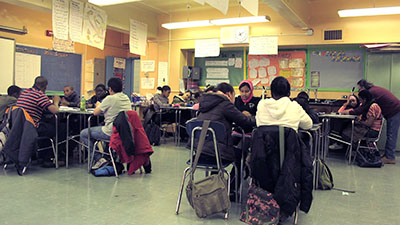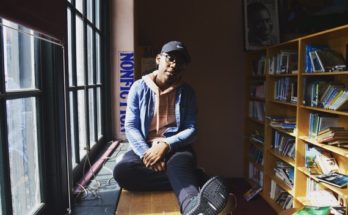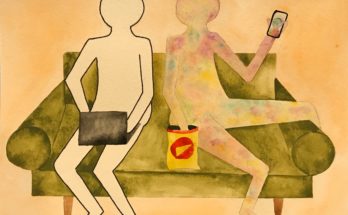Hawa Jalloh dodged groups of rowdy students as she wove her way through the crowded halls of Middle School 22 in the South Bronx one Monday morning in March. The seventh grader glanced into the assistant principal’s office where dozens of students were doing busy work – sharpening pencils and organizing office supplies, as penance for cutting class, something Jalloh could not imagine doing herself.

The plucky 13-year-old pressed into her seat in math class and opened her book, trying her best not to let the chaos around her interrupt her focus. Jalloh’s goal next year is to make it into Stuyvesant High School, one of New York’s eight selective public high schools.
Entrance to Stuyvesant and the seven other elite schools is based on a single 2.5 hour entrance exam, one that has increasingly led to a decline in the number of black and Latino freshmen over the last ten years. Jalloh faces great odds because Bronx middle schools send the fewest students to the selective high schools of any other borough. Only about 6 percent of the nearly 6,000 students admitted to the eight elite schools last year were from the Bronx, according to the Bronx Borough President’s office. Out of the 963 students accepted at Stuyvesant last month, only nine were black and 24 Hispanic, according to data released in March by the Department of Education.
But Jalloh believes she deserves the chance to be among the elite. Her high reading scores allowed her to enroll in the Department of Education’s specialized test prep program – a class that serves disadvantaged minority students who show potential for academic success but can’t afford private tutoring. Jalloh is one of only two students from her entire school who qualified for this program as a seventh grader.
On a cold Saturday afternoon in February, Jalloh awoke at 7 a.m. to take a train to the South Bronx Academy for Applied Media for four hours of math and English Language Arts prep at the Specialized High School Institute, or “DREAM” as it’s called, an acronym for Determination, Resilience, Enthusiasm, Ambition and Motivation. This chance for test prep opened up for her coincidentally. Until last year, the program only enrolled sixth graders, who were bused to one of the eight high schools for these Wednesday and Saturday sessions. This year, 18 sites were opened closer to the students’ homes, and seventh graders were admitted for the first time.
The program has gone through multiple changes in its leadership and curriculum in the last two decades. It began as a supplemental class for students who were falling behind in school, and later evolved into programs designed to build the foundations for test prep. Teaching in all subject areas was slowly whittled down to only help in English Language Arts and math – the two areas that are subject to standardized testing. It used to enroll all minority students, but it no longer admits Asians.
That morning, Jalloh walked into the school at Forest Avenue between Jackson and Trinton avenues to find only two-thirds of the students had shown up for the twice-a-week cram sessions. One student turned his back to the chalkboard, while another played games on his graphing calculator. Jalloh tried hard to pay attention, but she was distracted by the students and tired from staying up until midnight reading science fiction. She tapped her pencil on the table and tried to listen to her teacher, who was explaining how to solve polynomials, but her eyelids kept drooping and she kept falling behind.
“What’s the point of coming if you’re not engaged?” Jalloh said after class. “What we’re learning here is hard. And if you’re not going to pay attention, you might as well stay home.”

Jalloh said this course is her only chance to learn advanced math. Her teacher at MS 22 can’t help her further because she is on maternity leave. Jalloh didn’t feel comfortable turning to the substitute.
“In the beginning of class I’m more focused,” Jalloh said, even though she was hungry after eating only a bag of chips for breakfast. “During the middle of the class, the teacher adds more stuff on the board,” she said. “So that’s when it starts getting confusing, but I still catch up after looking closely at the board and trying to figure out how he got his answers.”
Although Jalloh is a bright and motivated student, the odds are not in her favor. If last year is any indication, enrollment in New York’s specialized high schools promises to become more competitive this year, and more racially skewed.
Only four percent of Stuyvesant students were black and Hispanic from 2008 to 2010, and the following year, that number dropped by one percent, according to the New York State School Report Card. Similarly, enrollment of minority students has declined in other elite high schools over the decade. At Brooklyn Technical High School, the number of black students dropped from 24 percent in 1999 to 10 percent in 2012, according to the Department’s enrollment demographics for that school.
These elite schools, which accept students based on their specialized high school test scores, continue to draw Asians at an increasing rate. At Stuyvesant last year, 72 percent of the students were Asian while 24 percent were white, 3 percent were Hispanic and 1 percent was black, according to the New York State School Report Card. The small numbers of black students who make the cut tend to find the race disparity to be alarming.
Last September, three civil rights and social justice organizations in New York City filed a federal civil rights complaint against New York’s Department of Education charging the city with barring low-income minority students from equal access to the top elite high schools. One key argument is that wealthier students have more opportunity to pay for private test preparation classes for the single admissions test required.
“We’re trying to hold the city and state accountable for a selection gap,” said Damon Hewitt, director of education practice at the NAACP Legal Defense Fund, one of the three legal counsels filing the lawsuit. “There are high achieving black and Latino students who are getting filtered out and not getting into the schools. The only basis to determine who gets into the schools is a single test.”
The standardized test for admissions to specialized high schools is “wrong on a number of fronts,” said Hewitt, adding that students who perform very well on one part of the exam and very poorly on another are more likely to get admitted compared to students who do equally well on both ELA and math but get only average scores.
In his 2008 case study on New York City’s specialized high school admissions, Deutsche Bank managing director and chief economist Joshua Feinman found that thousands of students who aren’t admitted into the elite schools have a “statistically indistinguishable” score from those who are admitted. That means these specialized high school exams, which are the sole determinant of admissions into the elite high schools, haven’t proven to be valid tools for measuring students’ achievement.
Malik Cayenne, a senior at Stuyvesant, is an anomaly. He is one of the few low-income minority students who did not take private test preparation for the exam because he didn’t want to give up his summers. He doesn’t believe in studying for standardized tests. You either know it, or you don’t he said.
Once he was accepted, he felt out of place. Students would ask ill-informed questions, like “Can you do the real Harlem Shake?” or “Where can I find the nearest KFC?”
“I thought, ‘Oh my gosh, am I the only black person at this school?’ Cayenne said. “It wasn’t until the start of the school year that I bumped into a few black people sitting outside the lunchroom and a few other people in an after school club that I began to feel comfortable.”
Few poor minority students can beat the odds like Cayenne, and most need a prep course like DREAM, which uses Kaplan’s test prep materials.
About 40 percent of the students in this DREAM program get accepted into a specialized high school, said math instructor Michael Cherubini, who has been teaching this prep course since it began. With the bar set fairly low for these students who are dedicating their time to prepare for the test, some show up to class an hour late or withdraw from the discussion altogether.
“On the first day I meet them, I say ‘I’m sure you know that out of all the people in here not 100 percent are going to go to Bronx Science, Stuyvesant, Tech or whatever else is out there,” Cherubini said. “But I say everybody here will profit from this experience. They’ll be some that make it, and they’ll be some that won’t. They all know that already. But they’re all here to learn more and that’s going to happen.”
Jalloh said that no matter where she goes she’ll be surrounded by people who are unmotivated to learn. And for now, she sits quietly in the back of the room doing her best to keep up in class, while managing her attitude and expectations.
“I think this program is giving me a leg up because everybody else is at home sleeping when I’m learning on Saturdays,” said Jalloh who was born in Guinea and lives with her dad who is a business man, her mom who is a nurse and five of her seven siblings in a neighborhood called Highbridge in the Bronx. “So I feel like I’m doing more than them, and I feel like I’ll have a better future than them.”
Despite the odds, she said she really wants to go to Stuyvesant, “but I won’t be that disappointed if I don’t because in the back of my mind, I have this voice telling me I might not pass it.”




i use to go to that school last year.